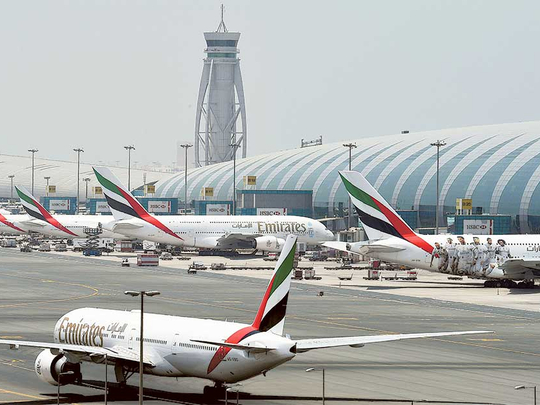
Dubai: Emirates’ decision to cut down on its US flights is being viewed by aviation industry experts as the right move, and one which will result in saving costs for the airline.
“I think it is the right move to save costs. They [Emirates] need to better match capacity and demand. So while it hurts revenue a bit, it does far more by cutting costs, and in the end they end up losing much less,” says Addison Schonland, Partner at US-based AirInsight.
Emirates made a commercial decision on Wednesday of reducing its flights to five of the 12 US cities it currently operates services to in the wake of the electronics ban and travel restrictions imposed by the Trump administration. The move has resulted in airline experiencing a drop in demand on the route.
Starting next month, the world’s largest long-haul carrier would scale down its services to Fort Lauderdale and Orlando (from May 1 and May 23 respectively); to Seattle and Boston (from June 1 and 2 respectively); followed by Los Angeles (from July 1).
‘Inevitable move’
Calling the move by Emirates an “inevitable” one, Andrew Charlton, managing director of Geneva-based Aviation Advocacy, said it would help Emirates cut costs. “And more importantly, it will let them correctly cut their suit to match their cloth. Or trim their network to match their passengers. In other words, it was the right move in the circumstances,” he told Gulf News by email.
He added that Emirates being a commercial airline “cannot be expected to absorb a downturn just because it disagrees with the way that a state is enforcing its policies.”
“These are clear commercial moves in response to a commercial reality — the decisions the US is taking are clearly having an impact on travel to and from the US and this reflects this,” Charlton said.
In March, Emirates President Tim Clark said its booking rates on US flights had fallen 35 per cent following US President Donald Trump’s travel ban in January barring people from Iran, Iraq, Libya, Somalia, Sudan, Syria, and Yemen from entering the US for 90 days. Iraq was, however, removed from the list in the revised order issued last month.
This was followed by a ban in March on certain electronic devices from US-bound flights from eight Middle East countries, including the UAE.
As another US-based aviation expert Ernest S. Arvai puts it: “The welcome mat has been removed by Donald Trump.”
“The ban on electronic devices from the Middle East airports simply makes it impossible for a business traveller to be productive using the Gulf airlines to fly. This has helped connections through Europe, while harming the more convenient non-stop flights from the Gulf to the US,” said the chief executive of The Arvai Group.
But analysts largely don’t seem too concerned about the impact of such bans on Emirates and other Gulf carriers. “The three big Gulf carriers — Emirates, Qatar Airways and Etihad Airways — have developed a higher brand awareness in the US already. When traffic picks up again, they can easily bring back the capacity,” according to Schonland.
On the other hand, the three US airlines — United, Delta and American Airlines — can’t do that as fast because they don’t have the fleet flexibility, he added. “In fact the three look like cutting back on long-haul orders and deliveries.
“So whatever dent there is for the three Gulf carriers, they will suffer a bruise at most. They can recover from that quickly,” Schonland said.
Commitment
Emirates, for its part, said on Wednesday that it would be closely monitoring the situation with the view to reinstate and grow its US flight operations as soon as viable.
“Emirates is committed to our US operations and will continue to serve our 12 American gateways with 101 flight departures per week, connecting these cities to Dubai and our global network of over 150 cities,” the airline’s spokesperson said in a statement.
Emirates currently flies to New York JFK, Newark, Boston, Washington DC, Chicago, Seattle, Los Angeles, San Francisco, Houston, Dallas, Fort Lauderdale, and Orlando in the US.
Following Wednesday’s decision of reducing US flights, it will move its Fort Lauderdale and Orlando operations from daily services to five a week, while the twice-daily services to Seattle, Boston and Los Angeles will be reduced to a daily service.
“There has been evidence from a number of travel websites that bookings to the US are down from a number of markets, which are important to Emirates. This is a notable step down in capacity and at this point not possible to predict how this will evolve,” said John Strickland, director of UK-based JLS Consulting. “The interesting question is how long the other Gulf carriers will persevere with their schedules,” questions Charlton.
Until the start of 2017, Emirates said its operations in the US saw a “healthy growth and performance”, driven by customer demand. It’s only in the last three months that the airline saw a significant decline in bookings on the route.
“Emirates and Qatar Airways have both seen that the traffic growth was not what they hoped. If there was so much traffic, the US majors would be in those markets already,” Schonland said.
Connecting traffic onward, however, is important for the Gulf carriers, according to Arvai, “with Asian destinations a key element of Emirates traffic.”
“But when demand falls, airlines need to cut capacity to maintain margins,” he said, adding that the downsizing of aircraft and frequencies is an “appropriate way” to react to those issues.











